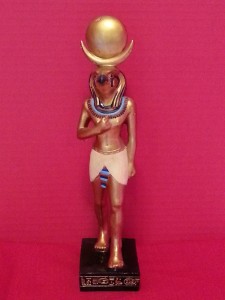What would you feel if you came face to face with a monument commemorating your death 2500 years ago? This is what happened to Aleister Crowley. He and his wife Rose conducted magical operations during their honeymoon in Cairo in 1904, and in the course of those operations Rose led Aleister to a funerary stele in the museum in Tahrir Square.
This stele was dedicated to a priest of Montu from Thebes in the 26th Dynasty. It was grouped with several others and is fairly representative of the type. It’s made of wood covered with stucco and stands about 20 inches tall by 12 wide. There are funerary stelae of both wood and stone dating from the 22nd to the 26th dynasty in museums around the world. The stelae often depict priests and priestesses and male and female members of priestly families. The practice of making stelae emerged in this turbulent period as a response to the phenomenon of tomb robbing. When it became clear that a tomb’s inhabitant might not sail into eternity undisturbed, the stele was created to act as a miniature tomb.
Funerary stelae reproduce the sacred structure of the tomb. The top of the stele is decorated with an image of the sky-goddess Nut, sometimes abbreviated to an arched border of blue-black, and there is a floor indicating the earth. Stelae often depict a winged solar disk, the sun which travels to and from the underworld each day, hopefully bringing the deceased along. This virtual temple also includes an offering table with various foods. The deceased, usually both pictured and named, offers the foods to various deities. In life the priests and priestesses offered food to deities and then consumed it themselves, and in death the deceased will also be sustained by the food offered to the deities.
The stele of Ankh-f-n-khonsu has an image image of Nut, the solar disk, a table of offerings, and an image of the god Re-Horakhty, Horus of the horizons. In Kemetic religion the two horizons map out to east and west, sunrise and sunset, river and desert, life and death. The priest Ankh-f-n-khonsu offers the table of food to Re-Horakhty.
Research conducted by Ixel Balamke and Hunahpu into this priest’s family indicates that this would probably be Ankh-af-na-khonsu V. His family had been priests of Montu since the 22nd Dynasty. His father was Besenmut IV and his mother was Tabetjet. Ankh-f-n-khonsu himself held the titles of prophet of Montu, prophet of Re-Horakty, and seal of the estate of Mut.
In addition to the stele, a mummy of the priest himself may still exist. In 1858 French archeologist Auguste Mariette discovered a cache of mummies of 71 priests of Montu. In 1891 French archeologist Georges Daressy discovered another cache of mummies of priests of Montu and of the royal families which was being looted by modern grave robbers. These were removed from the area, an act which is the subject of the film al-Mummia, in English The Night of Counting the Years. Among these mummies was at least one named Ankh-f-na-khonsu.
In 2004, one hundred years later, nineteen Thelemites made a sacred pilgrimage to Cairo to view the stele. Their account of the visit, along with excellent photographs of the stele in the museum, is on the Golden Lotus web site in an essay titled The Pilgrimage. During this visit they located a mummy of an Ankh-f-n-khonsu identified as dating to the 26th dynasty. Is this the same mummy that was moved by Daressy, the same man as the priest identified in the stele? It’s hard to be sure without checking with archaeologists but it is certainly suggestive.
In June 2008 I visited Cairo and made the pilgrimage to Tahrir Square. I couldn’t find any information about where the stele might be, so I ran through the rooms of the museum, growing increasingly agitated. I briefly considered calling my bishop and waking him up in the middle of his night to ask him what room it was in. Finally I found it, object 9422 in room 22, in a glass-fronted wooden case, displayed with a number of other stelae.
The photo on the Golden Lotus web page clearly pictures the stele in the glass case as I saw it. In 2011 the stele was removed from the glass case. Various Thelemic sources report that it is in storage with several other objects and will move to the new museum at Giza when it is completed. The Thelemic world is vastly relieved the object survived the civil uprisings. It is unclear whether the mummy the 2004 party saw also survived.
Text covers part of the front and the entire reverse of the stele. Aleister Crowley commissioned two translations of the Stele of Revealing during his lifetime. In 1986 the OTO commissioned a third. All three are published in the Holy Books of Thelema. They reproduce several verses of the Book of the Dead or the Book of Going Forth by Day, spells intended to aid the deceased in achieving the perpetual state of travelling with the sun daily back to the land of the living.
Doug Blake visited Egypt in 2013 in a spiritual pilgrimage. While he was not able to see the stele, as it is still packed away, he travelled extensively, speaking in Arabic as well as reading the hieroglyphs wherever he went. He has produced the newest translation of the stele, detailing exactly what the images represent and what the texts say, as well as speaking the texts. This has to be the definitive look at the stele from a Thelemic perspective.
[youtube]https://www.youtube.com/watch?v=Fo0IHL7dtU8[/youtube]
In Part 2 we’ll look at what all of this has to do with reincarnation.
Quick references
Balamke, Ixel and Hunahpu.“Will the Real Ankh-af-na-Khonsu please stand up?” Ophiocus, Quarterly Journal of Sekhet Bast Ra Lodge and Sol Invictus Camp of the O.T.O. Volume 10 Number 1, March 21, 2004.
Ordo Templi Orientis. Holy Books of Thelema. Samuel Weiser, York Beach, Maine, 2003


